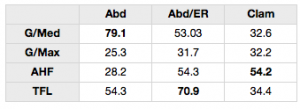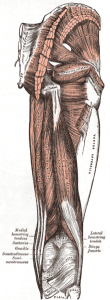Introduction Hamstring strains are commonly assessed and treated in the world of sports physiotherapy. They represent the most common injury in a number of sports, including AFL and soccer, accounting for up to 12-16% of injuries (Hawkins et al., 2001; Warren et al., 2010). Dvorak and Astrid (2000) suggested that hamstring injuries occur at an […]
How regularly do you treat injured athletes with reduced lower limb flexibility? The answer from many of you would likely be all day long! It has been well established that athletes with reduced lower limb flexibility are at greater risk of injury (Murphy et al., 2003). Thus, it would be logical that a program of regular stretching, which has been shown to improve lower limb flexibility (Harvey et al., 2002), would reduce this injury risk… wouldn’t it? Well, not conclusively…
Groin pain is a common complaint in sports involving running, kicking and explosive changes of direction, and as such is frequently encountered by the sports physiotherapist. In soccer, groin and lower abdominal pain accounts for 10-13% of injuries per year. However, due to the number of potential differential diagnoses for athletes with chronic pain in the groin and lower abdominal region only a small proportion of athletes are eventually diagnosed with athletic pubalgia (sports hernias). Athletic pubalgia is a poorly understood disease process and it is imperative that athletes with the condition are managed appropriately as the symptoms can eventually limit the athlete’s participation in training and playing.
It has been suggested that up to 79% of runners will sustain lower limb injuries. The patients with these pathologies frequently present with identifiable biomechanical faults associated with either deficits in pelvic strength or neuromuscular function. Thus, physiotherapists and physical therapists the world over implement rehabilitation programs aimed at strengthening the lateral hip abductors and external rotators. However, when it comes to exercise prescription for this musculature we require EMG studies to ensure that we are operating from a strong evidence basis. This article discusses such research.
We all know that hamstring strains are common injuries within sports that involve sprinting and jumping. In fact, they represent a significant proportion of muscle injuries: 50% in sprinting, 40% in soccer (Yeung et al, 2009) and 14% in Australian Rules football (Gabbe et al, 2006). They have been shown to be more common than any other muscle injuries and players are 2.5 times more likely to suffer a hamstring strain compared to a strain of their quadriceps (Woods et al, 2004). This is significant as Small et al (2010) found that soccer players miss on average 3 competitive matches per hamstring injury. Consider the huge impact on the success of sporting teams when high profile players are injured!
As sports physiotherapists we regularly assess and treat hamstring strains, sometimes on a daily basis! Hawkins et al. (2001) showed that hamstring injuries accounted for approximately 12% of football injuries, and thus are extremely common. Given their frequency, hamstring injuries have been discussed commonly on this site. However, to date, we have not paid much attention to the often recommended intervention of spinal manual therapy and its role in the evidence based management of hamstring strains….
In this episode of the podcast I interview Jeff Boyle. Dr Jeffrey Boyle is the Principal Physiotherapist at the Fremantle Dockers Football Club. Jeff is a Specialist Sports Physiotherapist (as awarded by the Australian College of Physiotherapists in 2009) as well as a Musculoskeletal Physiotherapist. Additionally Jeff is an Adjunct Senior Teaching Fellow at the University of Western Australia. In the interview we discuss…
As most sports physiotherapists would know, injuries of the groin are very common. This is particularly true in sports that require lateral movements and kicking; think football, rugby and AFL. In fact in some sports the incidence of groin pain is as high as 13%. This means that we are regularly assessing groin pathologies, and should be aware of the most effective and reliable techniques to assess deficits in adductor function. This article will discuss new research on the Adductor Squeeze Test that can inform and improve your clinical practice…
In the past this site has featured some lighter, colloquial blog posts. These articles discuss issues related to the greater physiotherapy community. Thus, I present a few mantras I have heard, adapted or made up for the physios to live by in the coming year.
Radial tunnel syndrome is rare, it is challenging to differentially diagnose and can be a monster to manage. If you have a recalcitrant case of tennis elbow then this post will interest you! This article discusses the best available evidence for assessment and management of radial tunnel syndrome.







